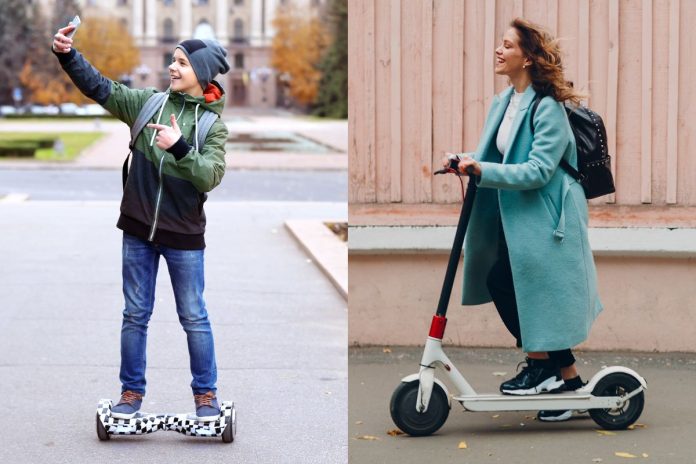In recent years, the popularity of hoverboards and electric scooters has grown, providing individuals with a handy and environmentally responsible form of transportation. However, like with any means of transportation, safety should always be the first consideration. In this comprehensive tutorial, we will look at a variety of safety guidelines for riding hoverboards and electric scooters. Whether you’re a beginner or an experienced rider, these recommendations will help you stay safe on the roads and sidewalks.
Understanding the basics
Before we get into particular safety precautions, it’s important to grasp the fundamentals of hoverboards and electric scooters. Both gadgets are powered by electricity and intended to carry people from one location to another. Hoverboards normally have two wheels and may be controlled by shifting your weight.
Proper safety gear is essential when riding hoverboards or electric scooters.
- Helmet: A well-fitting helmet is critical for keeping your head safe in the case of a fall or collision. Helmets built expressly for cycling or skateboarding provide higher protection.
- Knee and elbow pads: These can assist avoid injuries during a fall. Choose comfortable pads with enough cushioning.
- Wrist guards: These can help protect your wrists from fractures or sprains during a fall. Look for guards with solid construction and adjustable straps to ensure a snug fit.
- Reflective clothes: When riding at night or in low-light circumstances, wearing reflective clothing can boost your visibility to other drivers, lowering the chance of an accident.
Choosing the Right Location
Where you ride your hoverboard or electric scooter has a significant impact on your safety. Follow these suggestions to select the ideal spot for your ride:
- Avoid busy streets: Riding on busy streets with strong traffic increases the likelihood of an accident. Instead, use bike lanes, sidewalks, or designated paths whenever possible.
- Be aware of pedestrians: Always yield to pedestrians and allow them plenty of room when passing. When navigating busy situations, slow down and proceed with caution.
- Check local restrictions: Before you ride, educate yourself with the laws and regulations governing the use of hoverboards and electric scooters. Some locations may impose restrictions on where you can ride or require you to wear safety equipment.
- Stay off uneven terrain: Hoverboards and electric scooters work best on smooth, flat areas. Avoid cycling on uneven ground, such as gravel or grass, as this increases the danger of an accident.
Riding Techniques
Proper riding tactics are essential for remaining safe on a hoverboard or electric scooter. Follow these suggestions to improve your riding skills:
- Start slow: If you’re new to riding, start slowly and gradually increase your pace as you gain confidence. Before taking to the streets, practice basic moves like turning and stopping in a controlled area.
- Maintain balance: Keep your center of gravity low and centered over the board or scooter. To keep your body stable, bend your knees slightly and use your core muscles.
- Lean forward to accelerate: When riding a hoverboard, lean forward with your weight to propel the board forward. Similarly, on an electric scooter, gently press the throttle to speed. Begin with tiny motions and gradually increase speed to avoid losing control.
- Practice turning: To turn on a hoverboard or electric scooter, shift your weight in the desired direction. Begin by practicing mild turns in an open space, gradually increasing the angle as you gain confidence.
Awareness and Communication
To ride safely, you must be aware of your surroundings and communicate with other road users. To improve your awareness and communication, try the following tips:
- Use hand signals: When turning or changing lanes, signal your intentions to other drivers. Signal early and make eye contact with drivers to ensure they notice you.
- Be predictable: To prevent confusing other road users, ride predictably and respect traffic rules. Make your intentions clear and respect traffic lights and signage.
- Maintain a safe distance: Leave plenty of space between yourself and other drivers to allow for unexpected stops or movements. Avoid tailgating or riding too closely behind other vehicles, as this might increase the danger of an accident.
Weather Considerations
Weather conditions can have a huge impact on your safety when riding a hoverboard or electric scooter. Follow these guidelines to keep safe in different weather conditions:
- Avoid riding in the rain or snow: Wet or slippery roads make it harder to retain grip and control on your hoverboard or electric scooter. To reduce the danger of an accident, avoid riding in rain or snow.
- Dress appropriately: In cold conditions, layer up to keep warm and comfortable while riding. Wear waterproof clothing and footwear to protect oneself from rain and snow.
- Check tire pressure: Cold weather can create fluctuations in tire pressure, which might impair the functioning of your hoverboard or electric scooter. Check tire pressure before riding in cold conditions and adjust as needed for best performance.
In windy situations, use caution because strong winds can impair your riding stability and control. When riding in windy weather, exercise caution and be prepared to change your speed or route as needed to stay safe.














